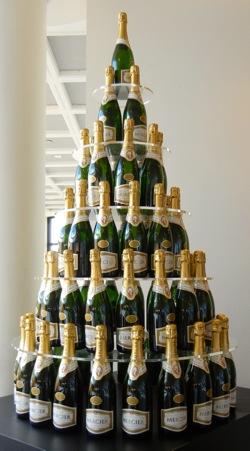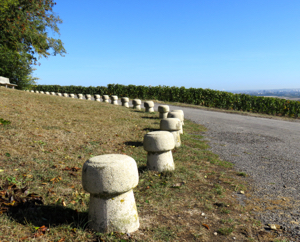 |
All About Champagne Wines | |
| No longer just for special occasions, champagne is a wine to drink anytime, especially with meals. | ||
|
|
|
Champagne has changed. Competition from other sparkling wines (crémant, mousseux, prosecco, cava, sekt, etc.) has propelled traditional champagne producers to introduce new blends and tastes to suit all palates, occasions and budgets—to your benefit. You can now start your evening à la française with the traditional glass of champagne en apéritif, most appropriately a light blancs de blancs made from 100% chardonnay grapes. With your first dinner course, try a blanc de noirs with pinot noir and perhaps some pinot meunier added to the blend. Main courses require more of the hearty pinot noir, less of the lighter chardonnay, and your wine may take on a rosé or even overtly red coloring. With your cheese course, favor a glass featuring more fruity pinot meunier in the blend. In short, to fully appreciate champagne wines, you need to know a bit about how they are made, from which grapes, and why. This information will also be useful if you decide to visit a champagne house. The Grapes of ChampagneTo call wine champagne, it must be produced in the Champagne region of France from grapes grown there. Only a few varietis of grapes are allowed in the production of champagne wine: ChardonnayThis green grape can mature in northern regions with shorter growing seasons and less sun. It develops slowly, yields a light- to medium-bodied wine with the bouquet of flowers and flavors of citrus and minerals, and ages well. Chardonnay adapts easily to different soils, climates and conditions, and takes on the flavors of its terroir. About 30% of Champagne's vineyards are planted in chardonnay, particularly the area known as the Côte des Blancs. Pinot NoirThe Champagne region produces more of this purple grape—38% of its vines—than of white chardonnay. The white juice of this grape adds body and a full flavor base to the wine. If the skins are included in the processing, the wine will be rosé or even red. Pinot MeunierThe fruitier pinot meunier completes the flavor profile of many champagne wines, bringing the blend together into a whole, round, saatisfying taste. Unlike chardonnay, meunier ages more quickly. The Marne Valley, around Château-Thierry southwest of Reims, is the perfect place to grow pinot meunier. Other VarietalsA few other varieties of grapes are approvied for inclusion in champagne wines—arbane, pino blanc, pino gris, petit meslier—but these are rarities, less than 1% of plantings. The Wines of ChampagneEach champagne winery has its own style of producing wines, optimized for its location: soil, minerals, exposure to the sun, number of growing days, etc. For example, if the winery's terrain favors pinot noir grapes, its wines will probably concentrate on blends containing a predominance of that grape. Thus, the region where a wine is made affects its flavor. Most champagnes include all three grape varieties, blended to achieve the champagne house's distinctive flavor profiles, but there are also: Blanc de blancsA wine made exclusively from chardonnay grapes, lighter, brighter and livelier than blends, perfect as an apéritif. Blanc de noirsMade from pinot noir, pinot meunier, or a blend of the two, blanc de noirs have fuller body and flavor, and more substance, good to accompany a meal. BrutThe driest (non-sweet) style of champagne, this is the style preferred by conoisseurs. Degrees of "dryness" range from Brut Zéro and Brut Nature (the driest), through Extra Brut, to Brut, and Extra-Dry/Extra-Sec (the sweetest brut). Demi-SecLiterally "half-sweet," this is in fact a sweeter wine than Brut or Extra-Sec, labeled as Dry (or Sec), Demi-Sec (most common) or Doux (the sweetest). MillésimeVintage wine, made from grapes of a particular year's harvest, with the year noted on the bottle. Vintage wines are usually made only in the best years, and are more expensive than non-vintage wines. Non-VintageWine made from grapes harvested in different years, blended to produce a winery's preferred style, maintaining consistency over the years. Méthode ChampenoiseThe way champagne wines are made, the méthode champenoise, is a lengthy process including the blending of various grape juices, two fermentations, manipulation of the bottles during aging (sometimes by hand), and the addition of several ingredients to achieve the flavor, characteristics, and alcoholic content desired. You can learn all about it on a visit to a champagne winery. Because the term méthode champenoise is trademarked, this method of making sparkling wines is usually called the traditional method (méthode traditionelle) in winemaking regions other than Champagne, and in countries other than France.
|
|
Above, Village among the vineyards in Champagne.
|




